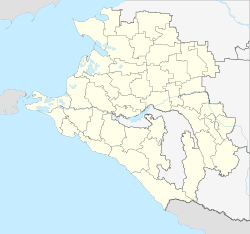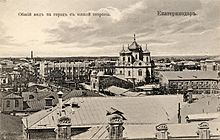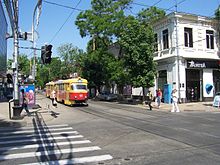Krasnodar
| city
Krasnodar
Краснодар
|
|||||||||||||||||||||||||||||||||||||||||||||
|
|||||||||||||||||||||||||||||||||||||||||||||
|
|||||||||||||||||||||||||||||||||||||||||||||
| List of cities in Russia | |||||||||||||||||||||||||||||||||||||||||||||
Krasnodar ( Russian Краснода́р ) is a major Russian city with over 1,000,000 inhabitants (2018), calculated on the entire urban district , which includes 29 other localities in addition to the actual city with a good 900,000 inhabitants. It is the capital of the Krasnodar region of the same name and one of the most important centers of southern Russia . Krasnodar is an important business location, is home to some of the most successful sports clubs in Russia and is the seat of several universities, theaters and museums. Around 1.35 million people live in the Krasnodar agglomeration. Until 1920 the city was named Ekaterinodar .
Krasnodar is a transport hub on the M4 trunk road with two long-distance train stations and an international airport .
geography
Krasnodar is located about 1200 km south of Moscow, exactly on the 45th parallel (like the Crimean peninsula ), between the Black Sea and the Caspian Sea . The southern city limit is marked by the Kuban River . Immediately south of Krasnodar runs the border with the Republic of Adygeja , an autonomous Russian republic. Some suburbs of Krasnodar, such as Jablonowski or Tljustenchabl , are already in Adygeja. There are also four large reservoirs in the south of the city. The straight line distance to the Black Sea is around 85 kilometers.
climate
Krasnodar has a sub-Mediterranean climate. The annual average daily temperature is 12.1 ° C, which is roughly the same as Bolzano .
|
Monthly average temperatures and rainfall for Krasnodar
Source: Roshydromet
|
|||||||||||||||||||||||||||||||||||||||||||||||||||||||||||||||||||||||||||||||||||||||||||||||||||||||||
history
Established as Jekaterinodar
Krasnodar was founded in 1793 under the name of Ekaterinodar (Екатеринодар) by the Black Sea Cossacks under the leadership of the ataman Sachari Tschepiga as a fortress city . The fortress was named Ekaterinodar, d. H. "Gift of Catherine", based on Catherine II , who had given the land to the Cuban Cossacks . Towards the end of the 19th century, 38% of the population still stated Ukrainian as their mother tongue (at the time it was regarded as the “Little Russian” dialect of Russian ; 53% “ Great Russian ”; in the entire Kuban area , Ukrainian was ahead of Russian with 47% 43%). As a result, the Ukrainian share fell due to various factors, such as the assimilation of Ukrainians and the migration of Russians and members of other ethnic groups from other parts of the country: in 1926, around 30% of the inhabitants of Krasnodar gave a Ukrainian ethnicity, in 1959 only just under 5% of the total Urban population of the region. This development continued, so that in 2010 only about 0.4% of the inhabitants of the region stated Ukrainian as their mother tongue.
After its founding, Ekaterinodar became the central base of the Black Sea Cossack army and in 1860 the capital of the Kuban region . In 1867, Ekaterinodar received city status. The population lived from agriculture. With the construction of the railroad in the late 19th century, the city began to grow, which became a major transport and trade center, especially for tobacco, bread and leather. In 1897 Krasnodar had 66,000 inhabitants, in 1913 there were already over 100,000.

Immediately after the October Revolution, Krasnodar came under the control of the Red Army, but was captured by the White Army under Kornilov and Denikin in April 1918 . The city then became one of the centers of the white, counter-revolutionary movement, which found numerous followers there, especially among the Cossacks.
Renamed Krasnodar
In 1920 the Red Army took the city. Immediately after the Soviets came to power, the city was renamed Krasnodar , giving it its current name.
In the 1920s and 30s the industrial development of the until then mainly agrarian city began, especially in the areas of metal processing and oil extraction and processing.
During the Second World War , Krasnodar was captured and occupied by Army Group A of the German Wehrmacht on August 9, 1942 . On February 12, 1943, the Red Army was able to recapture the city. During the fighting for Krasnodar there was serious destruction. In Krasnodar there was a prisoner of war camp 148 for German prisoners of war of the Second World War . The city quickly recovered from the damage caused by the war; in the 1970s the 500,000 population mark was exceeded. In order to be able to cope with the population growth, numerous new residential areas in the prefabricated building style were created.
In January 1961 there were mass demonstrations in Krasnodar against the policies of Nikita Khrushchev , which were broken up by the police after only two days.
Post-Soviet period
Unlike many other Russian cities, Krasnodar was barely hit by the collapse of the Soviet Union . Through transformation processes , Krasnodar was able to expand its position as an industrial center in the 1990s, and at the end of the decade it overtook nearby Rostov-on-Don in terms of industrial production and became the largest industrial location in the North Caucasus. Contrary to the general trend in Russia's demographic development, Krasnodar experienced a significant increase in population in the 1990s, which was partly due to a strong immigration of refugees from the crisis areas of the Caucasus and other former Soviet republics, but partly also to the favorable economic situation Development of the city. The population growth has continued since then.
population
Krasnodar is one of the Russian cities in which the birth rate is higher than the death rate. In addition, there is constant immigration from home and abroad, so that Krasnodar has seen steady population growth in recent years. In the 2010 census, over 90% of the population gave “Russian” as an ethnic origin. The largest minorities are Armenians (3.7%), Ukrainians (1.5%) and Adygians (0.9%). 54.6% of the population are female (2010). By 2015 the population rose to around 830,000 in the city itself and 1.35 million in the agglomeration. Among the largest cities in Russia, Krasnodar ranks 17th.
| year | Residents |
|---|---|
| 1897 | 65,606 |
| 1939 | 203,806 |
| 1959 | 313.110 |
| 1970 | 464.147 |
| 1979 | 560,438 |
| 1989 | 620.516 |
| 2002 | 646.175 |
| 2010 | 744.995 |
| 2015 | 829,677 |
Note: census data
economy
In the times of the Soviet Union, it was specifically developed as an industrial center, but today mainly refineries and large companies for the manufacture of tools and agricultural machines can be found here . The largest Russian retail company, Magnit , has its headquarters here, as does the photovoltaic company Solar Wind, which is now operating across Europe . Another economic mainstay of the city are agriculture, as well as tobacco, fruit and grain cultivation. The existing black earth makes the conditions for agriculture particularly favorable. Grain, sunflower and rice are exported to 69 countries. In the area of the city of Sochi, which belongs to the Krasnodar region, there is also the northernmost tea-growing region in the world.
As recently as the 1980s, plans were made to build the Krasnodar nuclear power plant with a VVER-1000 . However, on January 1, 1988, the plan was abandoned.
In 1993 Philip Morris International took over the state tobacco factory that had existed in the city since the 1930s and, after extensive renovation, continued it under the name of "Philip Morris Kuban" with 700 employees and a current production of 30 billion cigarettes per year.
The agricultural machinery manufacturer Claas has been operating an assembly plant since 2005, in which combine harvesters are manufactured for sale in the CIS countries . The construction components come mainly from Germany, but also from other European countries.
The construction industry in Krasnodar is very well developed compared to other Russian cities. In a comparison across Russia, Krasnodar, along with Moscow and Saint Petersburg, is one of the front runners in terms of the number of new buildings and the pace of construction. In 2011 alone, around 1,750,000 square meters of living space were created in Krasnodar.
On January 26, 2012, the Krasnodar City Duma approved a building and development plan for the next 40 years. The plan has been publicly available since February 2012.
traffic
Road and rail
Krasnodar is a transport hub on the M4 trunk road with two long-distance train stations and an international airport.
Transportation
The city's local public transport was practically handled solely by trams and numerous trolleybuses and bus routes until around 1990 .
After that, a new mode of transport flourished - the marshrutka . These are privately operated minibuses that travel relatively fixed lines, which are also requested, but also stop between two usual stops when called or signaled. Marshrutki tried out all the requested routes at lightning speed and in some areas are the only alternative to a taxi or your own vehicle. There are many more marshrutki than taxis or buses.
A typical vehicle of the marshrutki in Krasnodar is a minibus made in Nizhny Novgorod, reminiscent of the Ford Transit , called GAZelle , which uses engines that were also installed in the Volga- branded cars manufactured in the same plant .
Since July 2011 there has been the "EKOBus" in Krasnodar, an omnibus with an environmentally friendly hybrid drive . Furthermore, by the end of 2013, Krasnodar was the last city in the world to use double trolleybuses .
air
Krasnodar International Airport is located on the eastern outskirts of the Paschkowka settlement, which was incorporated a few years ago, about 12 kilometers from the city center.
Town twinning
Krasnodar lists nine twin cities :
-
 Tallahassee , USA
Tallahassee , USA
-
 Burgas , Bulgaria
Burgas , Bulgaria
-
 Karlsruhe , Germany
Karlsruhe , Germany
-
 Harbin , China
Harbin , China
-
 Ferrara , Italy
Ferrara , Italy
-
 Poltava , Ukraine
Poltava , Ukraine
-
 Wels , Austria
Wels , Austria
-
 Nancy , France
Nancy , France
-
 Larnaka , Cyprus
Larnaka , Cyprus
In 1979 the first contacts were made between Karlsruhe and Krasnodar. The two cities have been linked by an official friendship treaty since 1992, and they have been twin cities since December 1997. Numerous activities and visits from both sides strengthened the relationship. In addition to cultural exchange and personal encounters, the focus is on material and ideal assistance in the current process of restructuring Krasnodar.
Education and culture
The city has several theaters, libraries and museums, as well as a wide range of universities. It is the location of the largest agricultural university in Russia.
- Branch of the University of Consumer Cooperatives Belgorod
- Branch of the International University
- Branch of the Moscow State Trade University
- Branch of the Rostov State Transport University
- Branch of the Russian Economic Academy
- Institute for International Business
- Institute for International Law, Economics, Humanities and Administration
- Institute for International Entrepreneurship and Management of the Kuban Area
- Institute of Culture Krasnodar
- Institute for Management and Market of the International University
- Institute for Marketing and Social Information Technologies
- Institute for Modern Technologies and Economics
- Institute of Economics and Administration of the State Medical Academy of the Kuban Region
- Institute for Economics, Law and Natural Sciences
- Krasnodar Legal Institute of the Ministry of Interior of Russia
- Military Institute Krasnodar
- Military Aviation Institute Krasnodar
- Krasnodar City Medical Institute for Higher Nursing Education
- Medical Institute of the Kuban area
- Socio-economic institute of the Kuban area
- Kuban State Agricultural University
- State Academy of Sports of the Kuban Region
- Kuban State Medical University
- Kuban State Technological University
- Kuban State University
- Southern Management Institute
- South Russian Institute for International Relations
- University for Innovation in Entrepreneurship
- Megu-Krasnodar University
The writer Viktor Lichonossow, born in Siberia in 1936, lives in Krasnodar and publishes the literary magazine "Rodnaja Kuban" there. His novel "Our Little Paris" (Наш Маленький Париж), published in 1986, deals with the Cossack history of the city and is considered his main work. In 1988 he was awarded the state "Gorki Prize".
Sports
In football, the city is represented by the club FK Krasnodar in the Premjer League . In the city, individual games should have been played as part of the 2018 World Cup . However, Krasnodar was removed from the provisional list of venues alongside Yaroslavl .
FK Kuban Krasnodar , founded in 1928 , also played first-class for several years and took part in the group stage of the 2013/14 UEFA Europa League . The insolvent association was dissolved in 2018.
The short-lived hockey club HK Kuban Krasnodar played in the Vysschaya Hockey League from 2012 to 2015 .
PBK Lokomotive Kuban Krasnodar plays as a professional basketball club in the VTB United League .
In the city there is the GK Kuban Krasnodar, a well-known women's handball club of the Russian league.
Personalities
The sons and daughters of the city of Krasnodar include: a. the violinist and conductor Ilya Livschakoff (1903–1990), the bomber pilot and film director Yevgenia Schigulenko (1920–1994), general and politician Valentin Varennikow (1923–2009), football player Sergei Salnikov (1925–1984), the cosmonaut Gennady Padalka (* 1958), the opera singer Anna Netrebko (* 1971), basketball player Lazaros Papadopoulos (* 1980), gymnast Ina Schukawa (* 1986), tennis player Alexandra Panowa (* 1989) and handball player Anna Sen (* 1990).
Individual evidence
- ↑ Itogi Vserossijskoj perepisi naselenija 2010 goda. Tom 1. Čislennostʹ i razmeščenie naselenija (Results of the All-Russian Census 2010. Volume 1. Number and distribution of the population). Tables 5 , pp. 12-209; 11 , pp. 312–979 (download from the website of the Federal Service for State Statistics of the Russian Federation)
- ↑ Krasnodar Hits the Million Mark: Joins Russia's Big City List for First Time in Storied History. Retrieved October 6, 2018 .
- ↑ http://www.vedomosti.ru/politics/articles/2010/11/16/peredel_rossii
- ↑ 1897 census: native languages of the inhabitants of the city of Jekaterinodar (Russian)
- ↑ 1897 census: native languages of the inhabitants of the Kuban region (Russian)
- ↑ 1926 census: Ethnic composition of the urban population of Okrug Kuban (Russian)
- ↑ 1959 census: Distribution of the inhabitants of the Krasnodar region by gender, urban and rural population and ethnic group (Russian)
- ↑ 2010 census: Most numerous ethnic groups by mother tongue and federal subject (p. 258 (19); Russian)
- ↑ http://www.mojgorod.ru/krasnod_kraj/krasnodar/
- ↑ Maschke, Erich (Ed.): On the history of the German prisoners of war of the Second World War. Verlag Ernst and Werner Gieseking, Bielefeld 1962–1977.
- ↑ a b http://krsdstat.gks.ru/wps/wcm/connect/rosstat_ts/krsdstat/ru/news/rss/487e5a0047f0b4e5b6f6b6ed3bc4492f
- ↑ Power Reactor Details - KRASNODAR-1 . iaea.org. Archived from the original on June 4, 2011. Retrieved May 20, 2013.
- ↑ В Краснодаре в 2011 году ввели в эксплуатацию более 1 млн. кв. метров жилья ( Russian ) yuga.ru. January 16, 2012. Retrieved May 20, 2013.
- ↑ Генплан развития Краснодара поместили на электронную карту ( Russian ) yugopolis.ru. February 9, 2012. Retrieved May 20, 2013.
- ↑ Krasnodar - only a new vehicle and reduction of the offer , report on www.trolleymotion.eu from June 22, 2015 ( memento of the original from April 10, 2016 in the Internet Archive ) Info: The archive link was inserted automatically and has not yet been checked. Please check the original and archive link according to the instructions and then remove this notice.
- ↑ Krasnodar. In: transphoto.ru . Entry from December 31, 2013 (Russian).
- ↑ Sports Information Service : Football: World Cup 2018 host cities announced. (No longer available online.) In: zeit.de. Die Zeit , September 29, 2012, archived from the original on November 4, 2012 ; Retrieved July 31, 2013 . Info: The archive link was inserted automatically and has not yet been checked. Please check the original and archive link according to the instructions and then remove this notice.
Web links
- Official website of the city administration (Russian)
- Friendship Society Karlsruhe-Krasnodar
- City partnership Karlsruhe-Krasnodar














